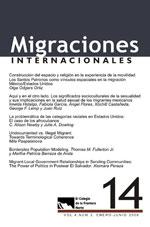Undocumented vs. Illegal Migrant: Towards Terminological Coherence
DOI:
https://doi.org/10.17428/rmi.v4i14.1158Palabras clave:
undocumented migrants, irregular migrants, terminology, conceptual analysis, illegal migrantsResumen
This article offers a terminological refl ection on the expression “illegal immigrant.”
In particular, it argues against the arbitrary choice of terminology used to refer to
undocumented migration in academic and scientifi c texts. On the basis of certain
legal, linguistic, and sociopolitical concerns, it suggests that the use of “illegal migrant/
alien” should be seriously reconsidered and replaced with alternative terms, such as
“undocumented” or “irregular immigrant,” which are both terminologically correct
and lack the negative social implications of the phrase “illegal immigrant/alien” or
“clandestine alien”.
RESUMEN
El propósito de este artículo es ofrecer una refl exión terminológica acerca de la expresión
“migrantes ilegales”. En particular, trata sobre el uso arbitrario de la terminología
empleada para referirse a la migración indocumentada en textos académicos y científi
cos. Tomando en consideración argumentos jurídicos, lingüísticos y sociopolíticos,
se señala que expresiones como “migrante ilegal” o “migrante clandestino” deben
considerarse seriamente y sustituirse con términos alternativos, tales como “migrante
irregular” o “migrante indocumentado”, los que, además de ser conceptualmente
correctos, son términos que evitan las implicaciones sociales negativas que tienen las
otras expresiones.
Referencias
Brenan, Ellen, “Irregular Migration: Policy Responses in Africa and Asia”, International Migration Review, 18(3), 1984, pp. 409-425.
Commission of the European Communities (EC), Communication from the Commission to the Council and the European Parliament on a Community Return Policy on Illegal Residents, 2002, com (2002) 564 final, Brussels, 14.10.2002.
Encyclopedia Britannica, Encyclopedia Britannica Online, 2006, Available online http://www.britannica.com/search?query= alien&ct=. Accessed January 12, 2006.
Ferrajoli, Luigi, Derecho y razón. Teoría del guarantismo penal, Madrid, Editorial Trotta, 2001.
Flores, Estevan, “Research on Undocumented Immigrants and Public Policy: A Study of the Texas School Case”, International Migration Review, 18(3), 1984, pp. 505-523.
Friman, Richard, “Informal Economies, Immigrant Entrepreneurship and Drug Crime”, Journal of Ethnic and Migration Studies, 27(2),2001, pp. 313-333.
International Organization for Migration (IOM), Essentials of Migration Management, IOM, 2005. Available online www.iom.int/en/PDF_Files/ idm2728092995/ presentations/Traffi cking_Final.pdf. Accessed on October 17, 2005.
Law Dictionary, Law.com Dictionary, 2006, Available at http://dictionary.law. com/. Accessed on January 15, 2006.
Marie, Claude-Valentine, Preventing Illegal Immigration. Juggling Economic Imperatives, Political Risks and Individual Rights, Council of Europe, CDMG, 2003.
Merriam-Webster, Merriam-Webster Online. Available at http://www.m-w.com/. Accessed on January 12, 2006.
Merriam-Webster’s Dictionary of Law, 1996, Available at http://dictionary.lp.fi ndlaw.com/. Accessed on January 12, 2006.
Pantoja, Adrian, “Against The Tide? Core American Values and Attitudes toward U.S. Immigration Policy in the Mid-1990s”, Journal of Ethnic and Migration Studies, 32(3), 2006, pp. 515-531.
Polinard, Jerry, Robert Wrinkle and Rodolfo de la Garza, “Attitudes of Mexican Americans Toward Irregular Mexican Immigration”, International Migration Review, 1984, 18(3), pp. 782-779.
Quassoli, Fabio, “Making the Neighbourhood Safer: Social Alarm, Police Practices and Immigrant Exclusion in Italy”, Journal of Ethnic and Migration Studies, 30(6), 2004, pp. 1163-1181.
Roxin, Claus, Strafrecht. Allgemeiner Teil 1: Grundlagen, der Aufbau der Verbrechenslehre, München, Beck, 1992.
Stevenson, Charles, Ethics and Language, New Haven, Yale University Press, 1969.
Stoddard, Ellwyn, “Conceptual Analysis of the ‘Alien Invasion’. Institutionalized Support of Illegal Mexican Aliens in the U.S.”, International Migration Review, 10(2), 1976, pp. 157-189.
United Nations (UN), International Bill of Human Rights. A Universal Declaration of Human Rights, General Assembly Resolution No. 217 A (III), UN, 1948.
———, Measure to Ensure the Human Rights and Dignity of all Migrant Workers, General Assembly Resolution No. 3449/XXX. UN, 1975.
———, Recommendations on Statistics of International Migration. Revision
, Statistical Papers Series M, No. 58, Rev. 1. Department of Economic and Social Affairs, Statistics Division, UN, 1998.
———, Supplemental Protocol to Prevent, Suppress and Punish Traffi cking
in Persons. Especially Women and Children Supplementing the United Nations Convention Against Transnational Organized Crime, UN, 2000a.
———, Protocol against Smuggling of Migrants by Land, See and Air Supplementing the United Nations Convention against Transnational Organized Crime, UN, 2000b.
Webster’s New School and Offi ce Dictionary and Atlas, Cleveland/New York, The World Publishing Company, 1943.
Fecha de recepción: 7 de mayo de 2007
Fecha de aceptación: 3 de septiembre de 2007
Descargas
Publicado
Número
Sección
Licencia
Las/los autoras/es que publiquen en esta revista aceptan las siguientes condiciones:
- Las/los autoras/es conservan los derechos de autor y ceden a la revista Migraciones Internacionales (RMI) el derecho de la primera publicación, mediante el registro de los textos con la licencia de Creative Commons Atribución-No comercial-Sin derivar 4.0 internacional (CC BY-NC-ND 4.0), que permite a terceros utilizar lo publicado siempre que mencionen la autoría del trabajo y a la primera publicación en esta revista.
- Autorizan que su artículo y todos los materiales incluidos en él sean reproducidos, publicados, traducidos, comunicados y transmitidos públicamente en cualquier forma o medio; así como efectuar su distribución al público en el número de ejemplares que se requieran y su comunicación pública, en cada una de sus modalidades, incluida su puesta a disposición del público a través de medios electrónicos o de cualquier otra tecnología, para fines exclusivamente científicos, culturales, de difusión y sin fines comerciales.
- Los autores/as pueden realizar otros acuerdos contractuales independientes y adicionales para la distribución no exclusiva de la versión del artículo publicado en esta revista (por ejemplo: incluirlo en un repositorio institucional, página web personal; o bien publicarlo en un libro) siempre que sea sin fines comerciales e indiquen claramente que el trabajo se publicó por primera vez en Migraciones Internacionales (RMI), [agregando la ficha bibliográfica correspondiente: Autor/es. (año). Título del artículo. Migraciones Internacionales, volumen (número), pp. doi: xxxx ].
Para ello, las/los autoras/es deben remitir el formato de carta-cesión de la propiedad de los derechos de la primera publicación debidamente llenado y firmado. Este documento debe cargarse en formato PDF en archivos complementarios dentro de la plataforma OJS.
Este obra está bajo una licencia de Creative Commons Atribución-No comercial-Sin derivar 4.0 internacional (CC BY-NC-ND 4.0)..













